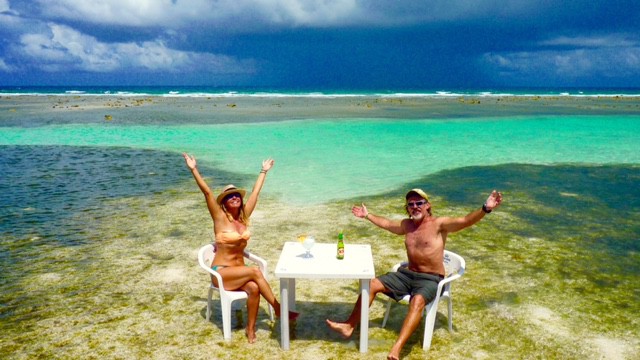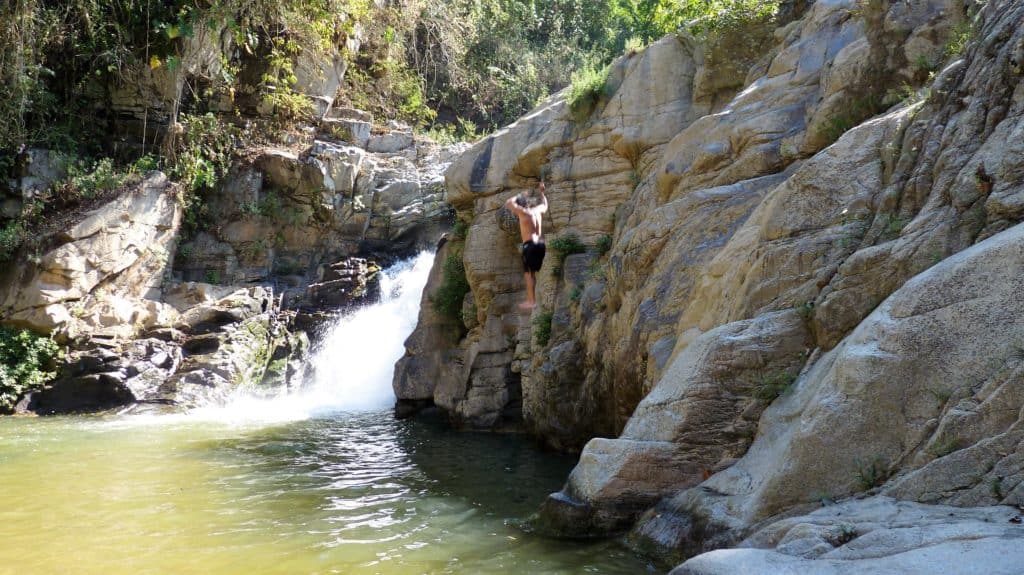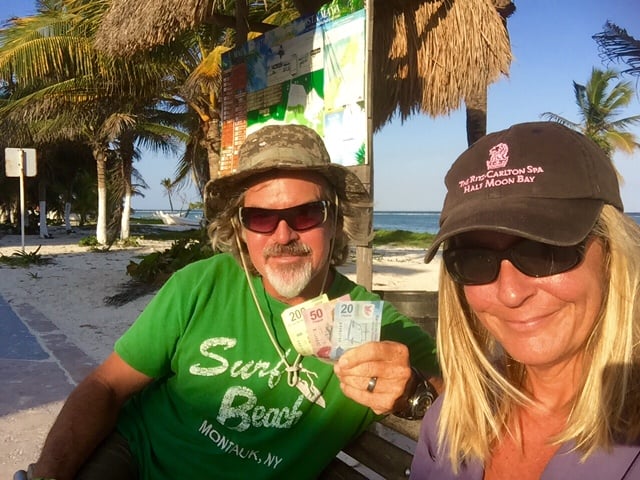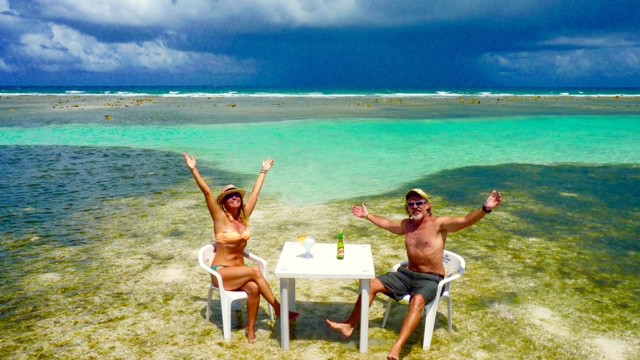Last Updated on June 3, 2023 by Ellen
(*Note, this blog post is co-authored with my spouse, Tedly. It’s the first entry where he’s had a role in the production. Usually he’s just my photo model.*)
Our first year of slow travel outside the U.S. in early retirement was fantastic. I’m most often asked what it costs and how we can afford it, if people aren’t too timid to ask those questions. We decided to share that information.
2016 living expense total
It was difficult to arrive at an exact figure for our year of slow travel abroad, because we actually lived in the U.S. for a full quarter in the middle 2016, and of course the U.S. is considerably more expensive than the other places we stayed last year – Mexico, Guatemala and Belize. We decided to keep the three months of U.S. living expenses in the total. Even though it wasn’t a foreign country, we were still retired and we weren’t working.
Our living expenses for 2016 totaled $31,202.
That figure includes our housing abroad as well as maintaining a home in the U.S. Although our Cleveland, Ohio, property is modest, it still requires payment of taxes, insurance and basic utilities even when it’s vacant.
A few of our other substantial expenses included: airfare; health care, a new laptop; gifts for family; charity donations; legal services for our wills; near-daily dining out.
Tourist excursions, or guided group tours, cost us $1,500. This doesn’t include entertainment activities we did on our own, such as museum admission.
Airfare cost us $1,500. That includes my emergency trip home in the first quarter. Luckily, we had good flight deals flying around Mexico later in the year on discount Mexican airlines like Volaris.
Our biggest expense in 2016 was housing. We spent $10,409 in this category, which, again, includes maintaining the Cleveland home.
For practical purposes, to see how much it actually cost to live, we omitted the costs for readying that house as a rental property, which we did over the summer. The money spent on the house is technically an investment – it was moved from a savings account to a different holding. The money spent on the house will provide a return.
We will net around $700 monthly if the tenant idea works out. In the future, that rental income will supplement savings and investments that fund our lifestyle. If it doesn’t work out, we can always sell the property.
For 2016, we had virtually no income, so it’s a bit concerning to see $31,202 in living expenses fly out of your possession with nothing coming in to replace it. With this background, next up is our plan for the year ahead.

2017 spending goal
We simply can’t afford to spend $31,000 every year. Moving forward, our goal is to spend under $24,000 annually, including the new rental income that we will receive. We think that number is a realistic, attainable goal. So where will we cut roughly $8,000?
In 2016, we spent at least an extra $5,000 that (hopefully) we won’t have to spend this year such as high-priced airfare or a new computer. We’ll try to minimize the guided group tours, and we won’t eat out nearly as often. Plus, we won’t have a higher cost of living if we’re not in the U.S. for three months of the year.
The remaining $3,000 can be saved by spending less on housing. We splurged with many hotel stays throughout 2016 and higher-priced Airbnb units because we wanted to be in hot spots during peak seasons. We wouldn’t trade our time on the Belize islands in high season or in Yelapa over Christmas and New Year’s. We have no regrets. That said, we will plot future destinations and rentals with a more frugal eye.

Of course, emergencies will happen. We’ll readjust our finances as needed, but we can’t live on the assumption the worst will happen. We’d rather enjoy today as much as possible, remaining cognizant of potential future unplanned dips into our funds. It’s a calculated risk we are willing to take to explore new places as we grow as people, and grow as a couple.
In 2016, we recorded our spending every day by hand in small notebooks that we’ve carried around. This year, I’m using a spending app that breaks everything down into nifty little pie charts and bar graphs, so we can easily see the categories within our budget. We expect to have much more detailed information on next year’s annual report.
How we can afford this lifestyle
Tedly planned for early retirement his entire adult life. I only latched on to the possibility when I was 32 years old, so while my savings and investments are substantially smaller than his, they are decent contributions nonetheless. Our combined assets should get us to the point where Tedly’s age-restricted accounts can be accessed without penalty to further contribute to our funds.

I’m 45, Tedly is 53, so we have six years before his retirement accounts could be tapped, but our goal is to hold off for a decade. We don’t live extravagantly, but we certainly are comfortable! For many American households, the biggest expenses are housing, food and transportation. It’s the same for us, only our housing, food and transportation all look different.
We aren’t staying in five-star resorts that you may be accustomed to when you book a week’s vacation from your daily grind. We usually stay in an area longer than a vacationer – call it ‘slow travel’ – to get a monthly discount on rent through Airbnb, or a multi-month price break on a furnished apartment. Sometimes the rentals lack basics, like cookware or coffee makers. But they all come with major furnishings so we never have to lay out money for things like beds or refrigerators.
Neither of us cooks much, so we eat a lot of veggies, beans, cereals, fruit, bread and cheese. Tedly will cook up meat or seafood or pasta about once a week. We’ll do that more in the future instead of eating out as much. Also, I don’t drink alcohol and Tedly is a bargain beer drinker. Mixed drinks or wine at restaurants cost nearly the same as bars back in the U.S. More liberal drinking habits could literally cost thousands of dollars extra each year.
Slow travel also cuts down on airfare costs, which can be a huge expense. If we were to fly from Mexico to India and back to Guatemala, that would blow the budget fast. Instead, we stay in a region until we see what we want to see, then move on. We travel by bus for medium-distances and also for local travel so we don’t need a car. Cars are huge expenses, so we eliminated them.
We have designed our lives this way – to travel while we are still young and our health is robust. Life is now, and we have put in enough dues.



Eventually, my retirement accounts also will come in handy. That should happen just as we’re ready to settle into rocking chairs somewhere warm, as we need more comforts for our old, weary bones, and as the cost of living in developing countries increases, as we anticipate it will. We sure will have some stories to tell, and hopefully, something left in the bank.
Other budget breakdowns:
- What it cost to travel in Western Europe for 3 months
- The real cost to retire in Chiang Mai, Thailand
- What we spent in 4 years of slow travel around the world


Hello, have you considered Roth IRA conversions w/ your $24k / personal exemption (married count) in order to access your retirement accounts early?
Yes, we are doing Roth conversions every year. It’s part of our long-term budgeting, tax, and spending plan.
We really have to balance current happiness and future finance. And it’s not easy for most.
We’re still learning!